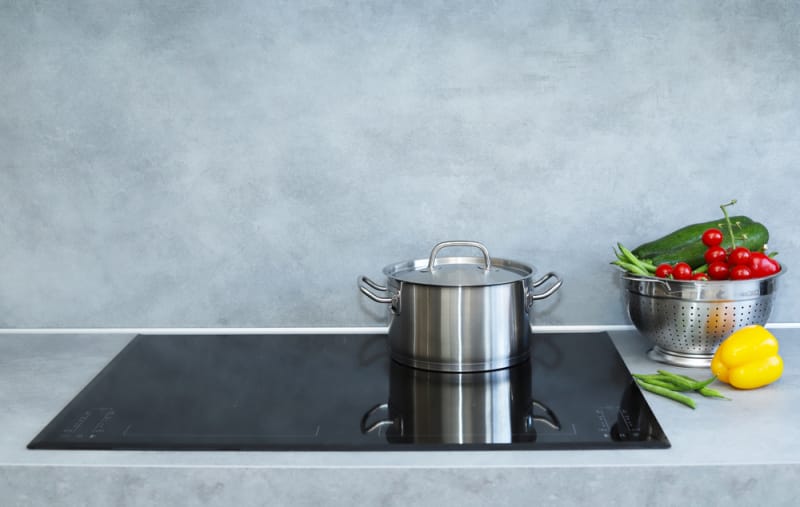Vegan Globetrotter is supported by our audience. When you purchase through one of our links, we may earn a small affiliate commission. As an Amazon Associate I earn from qualifying purchases. Your cost is not affected.
==================
Stepping into the world of induction cooking is an exciting kitchen upgrade, but navigating the array of cookware options can be a challenge. If, like me, you’re passionate about crafting delicious meals and recently embraced the efficiency of induction cooktops, finding the perfect ‘cookware for induction cooking’ becomes a culinary quest. In this journey, I’ll share insights, preferences, and tips to guide you in selecting the ideal pots and pans that harmonize seamlessly with the magnetic magic of induction technology. Let’s dive into the sizzle and style of induction-ready cookware together.
Types of Cookware for Induction Cooking

Induction cooktops are becoming increasingly popular in modern kitchens due to their energy efficiency and versatility. If you’re planning to make the switch, then you may be wondering what the best type of cookware for induction cooking is. Can you use your current pots and pans?
With so many choices out there, it can be difficult to choose the right one. Don’t worry – we’ve got your back! In this blog post, we’ll guide you through the various types of cookware that work great with induction stoves and provide tips on how to pick the ideal set for your kitchen needs. Let’s get started!
Introduction to Induction Cooktops and Cookware Compatibility
If you’re like me, you love cooking and trying out new recipes. Recently, I added an induction cooktop to our kitchen. And it completely changed my approach to cooking. Induction cooktops are energy-efficient, safe, and precise.
But they do require a bit of research when it comes to figuring out which cookware works best. In this guide, I’ll share everything I’ve learned about induction cooktop pans and help you find the perfect pots and pans for your kitchen.
Understanding Induction Technology and How It Affects Cookware
To understand why certain cookware is compatible with induction cooktops, we need to dive into the technology behind it. Unlike gas or electric stoves, induction cooktops use magnetic fields to heat the cookware directly. The cooktop’s surface remains cool while the pot or pan gets hot, making them safer and more energy-efficient.
For cookware to work on an induction cooktop, it must have a magnetic base. This means that not all pots and pans will work on an induction cooktop. It’s essential to know which materials are compatible and which ones to avoid. While most non-magnetic cookware will not damage your cookware and cooktop, they also won’t work.
Types of Cookware Compatible with Induction Cooktops
When it comes to induction cooktop pans, the primary factor to consider is the material. Here are some of the most common materials used for induction-compatible cookware:
- Stainless Steel: Stainless steel is one of the best materials for induction cooktops. It’s durable, non-reactive, and has excellent heat distribution properties. Look for stainless steel cookware with a magnetic base or specifically labeled as induction-compatible.
- Cast Iron: Cast iron is another popular choice for induction cooktops. It’s heavy-duty, retains heat well, and can be used for a variety of cooking techniques. Just be careful when using cast iron on the cooktop, as it can scratch the surface if not handled properly.
- Carbon Steel: Carbon steel is similar to cast iron but lighter and more responsive to heat changes. It’s a popular choice for woks and frying pans, and it works well on induction cooktops.
- Enameled Cast Iron and Enameled Steel: These types of cookware have a porcelain enamel coating that makes them non-stick and easy to clean. As long as the base is magnetic, they can be used on induction cooktops.
- Induction-ready Non-stick Cookware: Some non-stick pots and pans are made specifically for induction cooktops. They usually have a stainless steel or magnetic base, which allows them to work with induction technology.
Best Cookware for Induction Cooktops
Now that we know what types of cookware are compatible with induction cooktops, let’s discuss the best options for different cooking needs. Here are my top recommendations for each type of cookware:
Frying Pan:
Look for a stainless steel, cast iron, or carbon steel frying pan with a magnetic base. These materials provide excellent heat distribution and are perfect for searing, sautéing, and frying.
Saucepan:
A stainless steel saucepan with a heavy-bottomed base is ideal for cooking sauces, soups, and grains on an induction cooktop. The heavy base ensures even heat distribution and prevents scorching.
Note that if your stainless steel pots have the copper bottom, they may not work on induction cooking surfaces. Some do have a metallic surface area but many do not.
Stockpot:
A large stainless steel stockpot is perfect for making big batches of soup, chili, or pasta. Make sure it’s induction-compatible and has a heavy base for even heat distribution.
Dutch Oven:
Enameled cast iron Dutch ovens are often a top pick for slow cooking and braising on an induction cooktop. They retain heat well, and the enamel coating makes them easy to clean.
However, I still prefer my non-enameled cast iron dutch oven. The enameled surfaces are beautiful, but my well-seasoned dutch oven works just as well and was already in my kitchen when I made the switch to an induction cooktop.
Wok:
Carbon steel woks are the best choice for induction cooktops, as they heat up quickly and evenly. Just make sure it has a flat bottom to ensure proper contact with the cooktop.
I use my carbon steel wok nearly as much as my skillets. They work well for Asian cooking but I also use mine for other cuisines, too.
Features to Look for in Induction Compatible Cookware
When shopping for induction cooktop pans, consider the following features to ensure you’re getting the best cookware for your needs:
- Magnetic Base: The most important feature, as mentioned earlier, is a magnetic base. This is what allows the cookware to work with induction technology. Non-magnetic just won’t work with induction cooking.
- Heavy Bottom: A heavy bottom ensures even heat distribution and reduces the risk of scorching or burning your food.
- Comfortable Handles: Look for cookware with comfortable, heat-resistant handles that make it easy to move your pots and pans from the cooktop to the oven or table.
- Lids: Tight-fitting lids help retain heat and moisture, making your cooking more efficient.
-
Easy to Clean (Dishwasher Safe): For easy cleanup, opt for induction-compatible cookware that’s easy to clean and dishwasher safe. Of course, if you don’t use a dishwasher, this won’t apply. But a surface that cleans easily still applies.
How to Test If Your Current Cookware Works on an Induction Cooktop
If you’re not sure whether your current pots and pans are induction-compatible, try this simple test: Place a magnet on the bottom of the cookware. If it sticks, it’s likely induction-friendly. And if it doesn’t, you’ll need to invest in new cookware.
Common Mistakes When Using Cookware with Induction Cooktops
To ensure your induction cooktop pans last and perform at their best, avoid making these common mistakes:
- Using Incompatible Cookware: As mentioned earlier, using non-magnetic cookware on an induction cooktop does not work. You need to use cookware with a magnetic bottom to work with induction cooking.
- Dragging Cookware Across the Surface: Dragging pots and pans across the cooktop surface creates scratches. Always lift your cookware when moving it, just as you would on a glass top electric stove.
- Overheating Empty Cookware: Induction cooktops heat cookware quickly, so avoid preheating empty pots and pans for too long, as it can cause damage. In fact, for most cooking, preheating is not necessary.
- Not Cleaning the Cooktop Regularly: Spills and residue can accumulate on the cooktop, potentially causing damage. Clean your induction cooktop regularly with a soft cloth and a cooktop-safe cleaner.
Maintenance and Care of Induction Cookware
Proper care and maintenance will help extend the life of your induction cooktop pans. Here are some tips:
Wash Cookware Before First Use:
Always wash new cookware with warm, soapy water to remove any manufacturing residue. In fact, we do this with cookware and utensils.
Follow Manufacturer’s Instructions:
Each type of cookware may have specific care instructions. Be sure to read and follow them.
Clean cast iron skillets and carbon steel cookware with the proper tools.
When properly seasoned, cast iron and carbon steel usually require just a quick wash, dry, and light oil after use. If a food sticks, a stiff brush helps to remove the residue.
Use Non-Abrasive Cleaning Tools When Recommended by Manufacturer:
To avoid scratching your cookware, use non-abrasive cleaning tools like soft cloths, sponges, or nylon scrubbers when recommended by the manufacturer.
Avoid Rapid Temperature Changes:
To prevent warping, avoid exposing your cookware to rapid temperature changes, such as plunging a hot pan into cold water.
Store Properly:
Store your cookware in a cool, dry place, and avoid stacking heavy pots on top of lighter pans to prevent damage. Also, if your cookware has a non-stick finish, avoid stacking anything inside it without a soft cloth or towel between them.
Unveiling the Induction Culinary Symphony
As we conclude our exploration into the realm of cookware for induction cooking, I hope this journey has provided you with valuable insights and confidence in choosing the perfect kitchen companions. The harmonious marriage of magnetic prowess and quality materials opens the door to a world of culinary possibilities.
Remember, the key to mastering induction cooking lies not only in the precise technology of your cooktop but also in the magnetic embrace of your pots and pans. Whether you’re sizzling up a stir-fry in a carbon steel wok or simmering a savory stew in an enameled cast iron Dutch oven, the right cookware makes all the difference.
Now, armed with the knowledge of induction-friendly materials and essential features, embark on your culinary adventures with the assurance that your cookware is ready to dance with the magnetic melodies of induction technology.
Ready to elevate your kitchen experience? Explore our recommended induction-ready cookware sets and unlock a world of efficient, flavorful cooking. Let the induction culinary symphony begin!
FAQs About Induction Compatible Cookware
Can I use aluminum or copper cookware on an induction cooktop?
A: Aluminum and copper cookware are not magnetic, so they won’t work on an induction cooktop unless they have a magnetic base or are specifically designed for induction cooking.
What happens if I use non-induction cookware on an induction cooktop?
A: Using non-induction cookware on an induction cooktop won’t work. In most cases, it won’t damage the cookware or the cooktop. But without triggering the magnetic field interaction, the induction cooktop won’t start . Additionally, some cookware might scratch or damage the cooktop’s surface. Make sure your cookware is magnetic.
Can I use glass cookware on an induction cooktop?
A: Most glass cookware is not compatible with induction cooktops because it’s not magnetic. However, some manufacturers make induction-compatible glass cookware with magnetic bases.
Do I need to use special utensils with induction cookware?
A: No, you don’t need to use special utensils with induction cookware. However, avoid using utensils with rough or sharp edges that can scratch the cookware’s surface.
🌱 Embark on a Culinary Journey with Us! 🌍✨
Discover the world of cruelty-free cooking at Vegan Globetrotter. 🍲🌿 Dive into captivating content, insightful product reviews, and join a vibrant community passionate about vegan cookware. Connect with us on:
Unleash your inner chef and explore the art of plant-based cooking with us! 🚀🍽️ #VeganCuisine #CookwareCommunity #VeganLife












Don't miss out
when new recipes and information are added!
Join our newsletter for free recipes,
healthy living inspiration, and special offers
You have Successfully Subscribed!